1990 VOLKSWAGEN TRANSPORTER tire type
[x] Cancel search: tire typePage 80 of 165
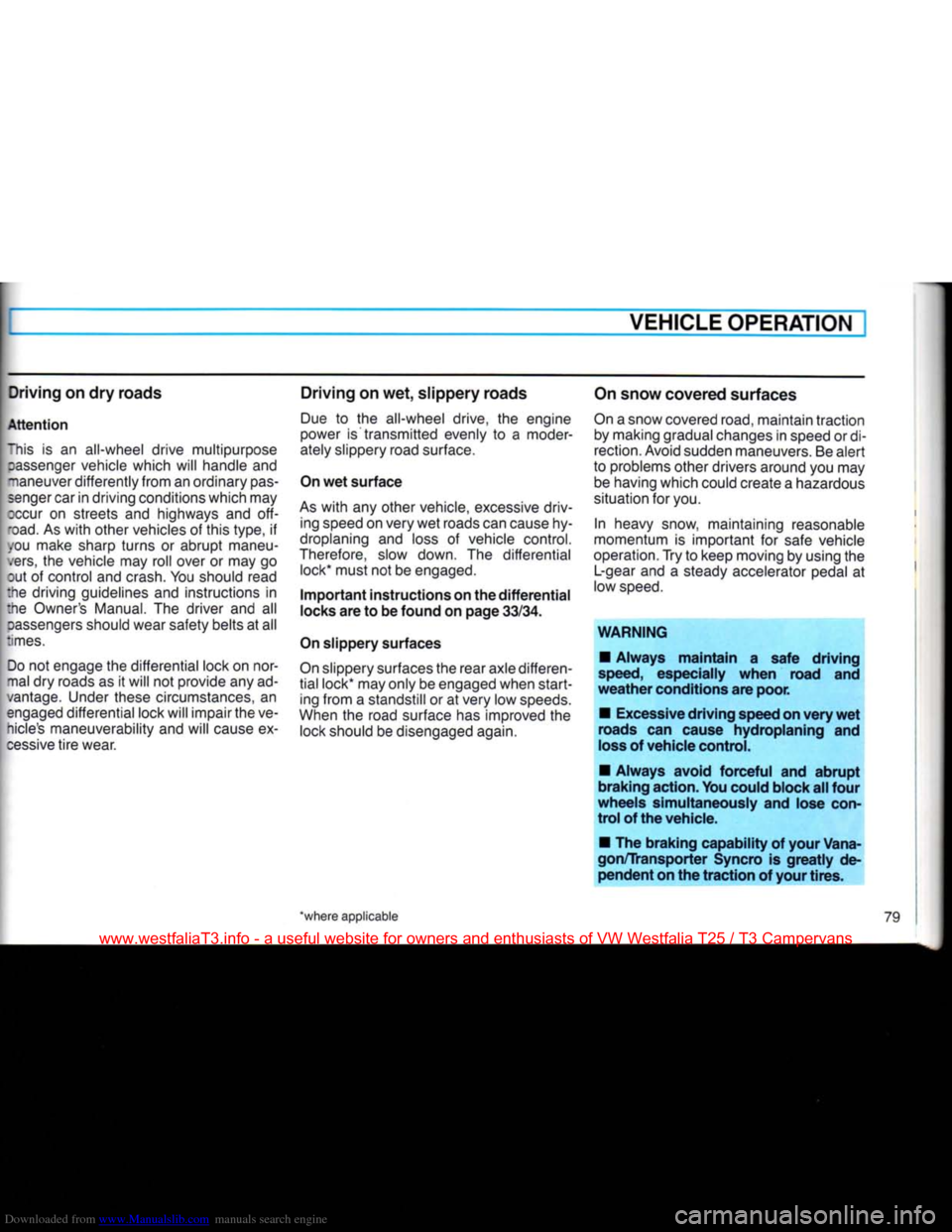
Downloaded from www.Manualslib.com manuals search engine
-
VEHICLE
OPERATION
Driving on dry roads
Attention
"his
is an
all-wheel drive multipurpose
rassenger
vehicle which
will
handle
and
maneuver
differently
from
an ordinary
pas
senger
car in driving conditions which may
occur
on
streets
and
highways
and off-
'oad.
As
with
other vehicles
of
this type,
if
you make sharp turns
or
abrupt maneu
vers,
the
vehicle
may
roll over
or
may
go
kit
of
control and
crash.
You should read
:he driving guidelines
and
instructions
in
the Owner's
Manual.
The
driver
and all
oassengers
should wear safety belts
at all
times.
Do
not
engage
the
differential lock on nor
mal
dry
roads
as it
will
not
provide any ad
vantage. Under these circumstances,
an
engaged differential lock
will
impair the ve-
nicle's
maneuverability and
will
cause
ex
cessive
tire
wear.
Driving on wet, slippery roads
Due
to the
all-wheel drive,
the
engine
power
is
transmitted evenly
to a
moder
ately slippery road surface.
On
wet surface
As
with
any
other vehicle, excessive driv ing speed on very wet roads can cause hy
droplaning
and
loss
of
vehicle control.
Therefore, slow down.
The
differential lock* must
not be
engaged.
Important
instructions
on
the
differential
locks
are to be found on page
33/34.
On
slippery surfaces
On
slippery surfaces the rear axle differen
tial
lock may only be engaged when
start
ing
from
a
standstill
or at
very low
speeds.
When
the
road surface has improved
the
lock should
be
disengaged again. On
snow covered surfaces
On
a
snow covered road, maintain traction by making gradual changes
in
speed
or
di
rection. Avoid sudden maneuvers. Be alert
to problems other drivers around you may be having which could create
a
hazardous
situation
for
you.
In heavy snow, maintaining reasonable
momentum
is
important
for
safe vehicle
operation. Try
to
keep moving
by
using
the
L-gear and
a
steady accelerator pedal
at
low
speed.
WARNING
•
Always
maintain
a safe driving
speed,
especially
when
road and
weather
conditions are poor.
•
Excessive
driving speed on very wet
roads can cause hydroplaning and
loss
of vehicle control.
•
Always avoid forceful and
abrupt
braking action.
You
could block all four
wheels simultaneously and lose
con
trol
of the vehicle.
•
The braking capability of your Vana-
gon/Transporter Syncro is
greatly
de
pendent on the
traction
of your tires.
'where applicable 79
www.westfaliaT3.info - a useful website for owners and enthusiasts of VW Westfalia T25 / T3 Campervans
Page 121 of 165
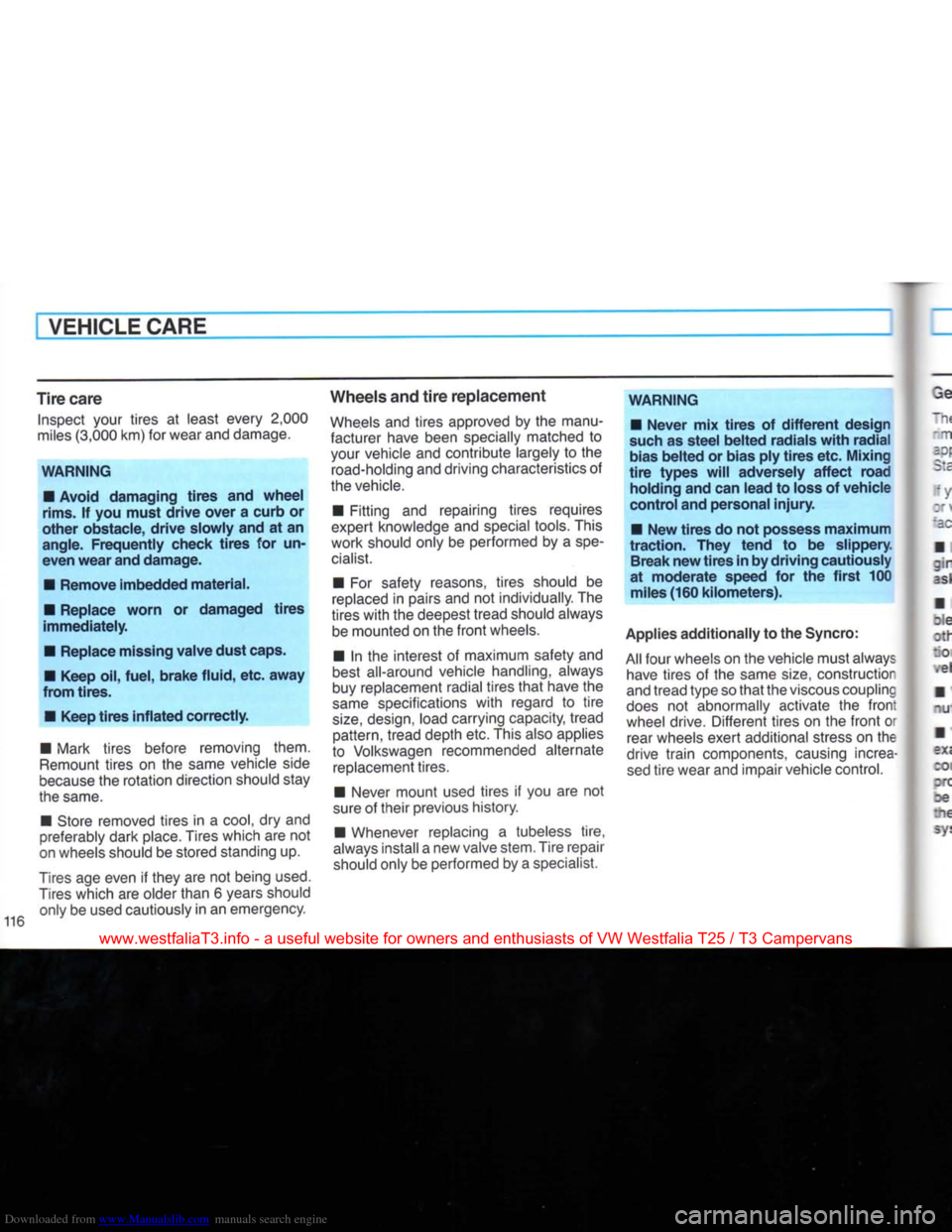
Downloaded from www.Manualslib.com manuals search engine
VEHICLE CARE
Tire
care
Inspect your tires at least every 2,000
miles (3,000 km) for wear and damage.
WARNING
• Avoid
damaging
tires
and
wheel
rims.
If you
must
drive
over
a
curb
or
other
obstacle,
drive
slowly
and at an
angle.
Frequently
check
tires
for un
even
wear
and
damage.
•
Remove
imbedded
material.
•
Replace
worn
or
damaged
tires
immediately.
•
Replace
missing
valve
dust
caps.
• Keep oil,
fuel,
brake
fluid,
etc.
away
from
tires.
• Keep
tires
inflated
correctly.
• Mark tires before removing them.
Remount tires on the same vehicle side
because
the rotation direction should stay
the same.
• Store removed tires in a
cool,
dry and
preferably dark place. Tires which are not
on wheels should be stored standing up.
Tires
age even if they are not being
used.
Tires
which are older than 6 years should only be used cautiously in an emergency.
Wheels
and
tire
replacement
Wheels
and tires approved by the manu
facturer have been specially matched to
your vehicle and contribute largely to the road-holding and driving characteristics of
the vehicle.
• Fitting and repairing tires requires
expert knowledge and special tools. This
work should only be performed by a
spe
cialist.
• For safety reasons, tires should be
replaced
in pairs and not individually. The
tires
with
the deepest tread should always be mounted on the
front
wheels.
• In the interest of maximum safety and
best all-around vehicle handling, always
buy replacement radial tires
that
have the
same
specifications
with
regard to
tire
size,
design, load carrying capacity, tread pattern, tread depth etc. This also applies
to Volkswagen recommended alternate replacement tires.
• Never mount used tires if you are not
sure of their previous history.
• Whenever replacing a tubeless tire,
always install a new valve stem. Tire repair
should only be performed by a specialist.
WARNING
•
Never
mix
tires
of
different
design
such as
steel
belted
radials
with
radial
bias
belted
or
bias
ply
tires
etc.
Mixing
tire
types
will
adversely
affect
road
holding
and can
lead
to loss of
vehicle
control
and
personal
injury.
• New
tires
do not possess
maximum
traction.
They
tend
to be
slippery.
Break
new
tires
in by
driving
cautiously
at
moderate
speed for the
first
100
miles
(160
kilometers).
Applies
additionally
to the Syncro:
All
four wheels on the vehicle must always have tires of the same
size,
construction
and tread type so
that
the viscous coupling
does
not abnormally activate the
front
wheel drive. Different tires on the
front
or rear wheels exert additional stress on the
drive
train
components, causing increa
sed
tire
wear and impair vehicle control.
www.westfaliaT3.info - a useful website for owners and enthusiasts of VW Westfalia T25 / T3 Campervans
Page 122 of 165
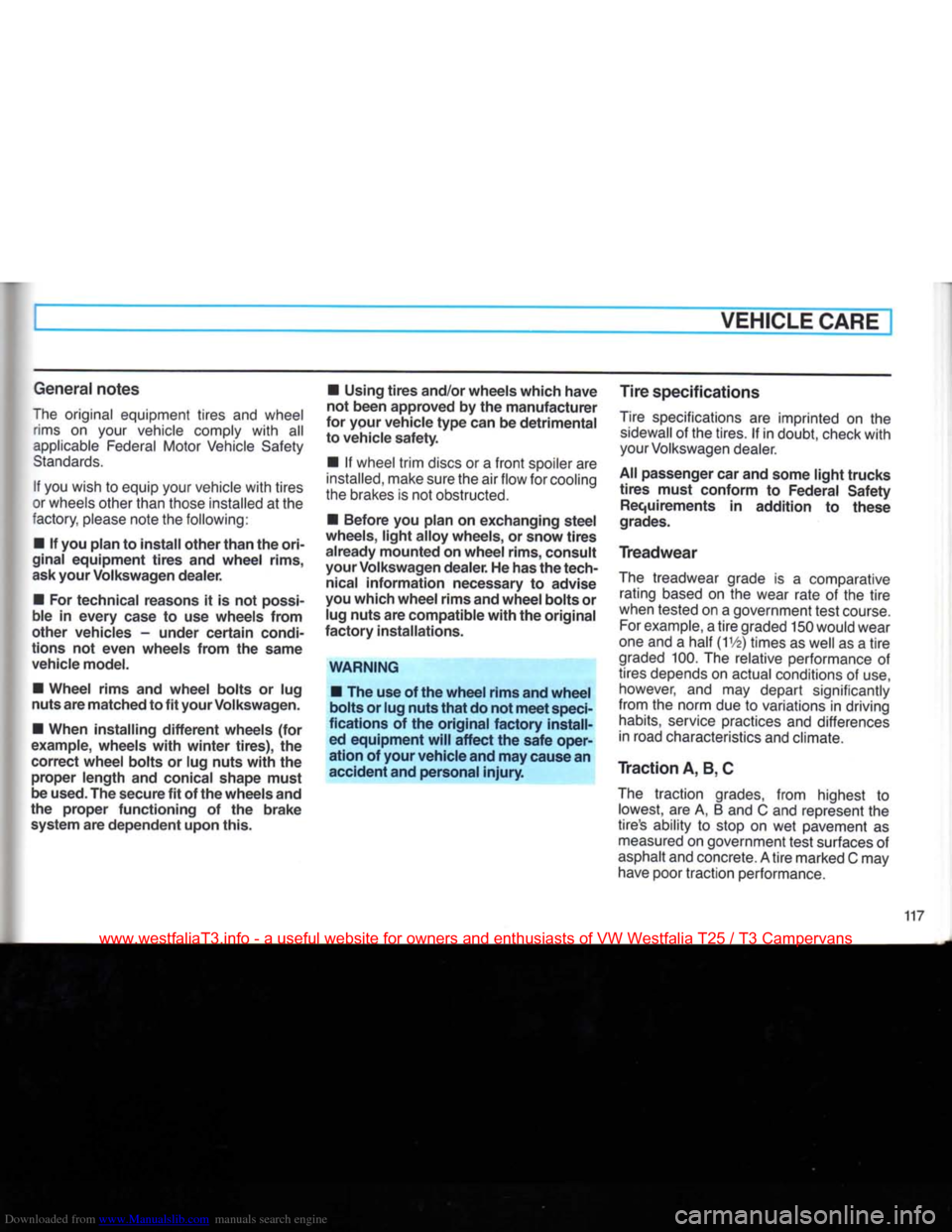
Downloaded from www.Manualslib.com manuals search engine
VEHICLE
CARE
General notes
The original equipment tires
and
wheel
rims
on
your
vehicle comply with
all
applicable
Federal Motor Vehicle Safety
Standards.
If you
wish
to
equip
your
vehicle with tires
or wheels other than those installed
at the
factory, please note
the
following:
•
If
you plan
to
install other than the
ori
ginal
equipment tires
and
wheel rims,
ask
your
Volkswagen dealer.
•
For
technical reasons
it is not
possi
ble
in
every
case
to use
wheels from
other vehicles
-
under certain condi
tions
not
even wheels from
the
same
vehicle
model.
•
Wheel rims
and
wheel bolts
or lug
nuts are matched to fit
your
Volkswagen.
•
When installing different wheels
(for
example,
wheels with winter tires),
the
correct wheel bolts
or
lug nuts with
the
proper length
and
conical shape must
be used. The secure fit of the wheels and
the proper functioning
of the
brake system are dependent upon this.
•
Using tires and/or wheels which have
not been approved
by
the manufacturer
for
your
vehicle
type
can be detrimental
to vehicle safety.
•
If
wheel trim discs
or a
front
spoiler
are
installed,
make
sure the airflow for cooling
the brakes
is not
obstructed.
•
Before
you
plan
on
exchanging steel
wheels, light alloy wheels,
or
snow tires
already mounted on wheel rims, consult
your
Volkswagen dealer. He has the tech
nical
information necessary
to
advise
you which wheel rims and wheel bolts
or
lug
nuts are compatible with the original
factory installations.
WARNING
•
The
use of the wheel rims and wheel
bolts
or
lug nuts that do not meet
speci
fications
of the
original factory
install
ed equipment will affect the safe oper
ation
of
your
vehicle and may cause an
accident and personal
injury.
Tire specifications
Tire
specifications
are
imprinted
on the
sidewall
of
the tires.
If in
doubt, check with
your
Volkswagen dealer.
All
passenger car and some light trucks tires must conform
to
Federal Safety
Requirements
in
addition
to
these
grades.
Treadwear
The treadwear grade
is a
comparative
rating
based
on the
wear rate
of the
tire
when tested
on a
government test course. For example,
a
tire graded
150
would wear
one
and a
half
(IV2)
times
as
well
as a
tire
graded 100.
The
relative performance
of
tires depends
on
actual conditions
of use,
however,
and may
depart significantly
from
the
norm
due to
variations
in
driving
habits,
service practices
and
differences
in road characteristics and
climate.
Traction A, B, C
The traction grades, from highest
to
lowest,
are A, B and C and
represent
the
tire's ability
to
stop
on wet
pavement
as
measured
on
government test surfaces
of
asphalt
and concrete. Atire marked
C
may
have poor traction performance.
www.westfaliaT3.info - a useful website for owners and enthusiasts of VW Westfalia T25 / T3 Campervans
Page 123 of 165
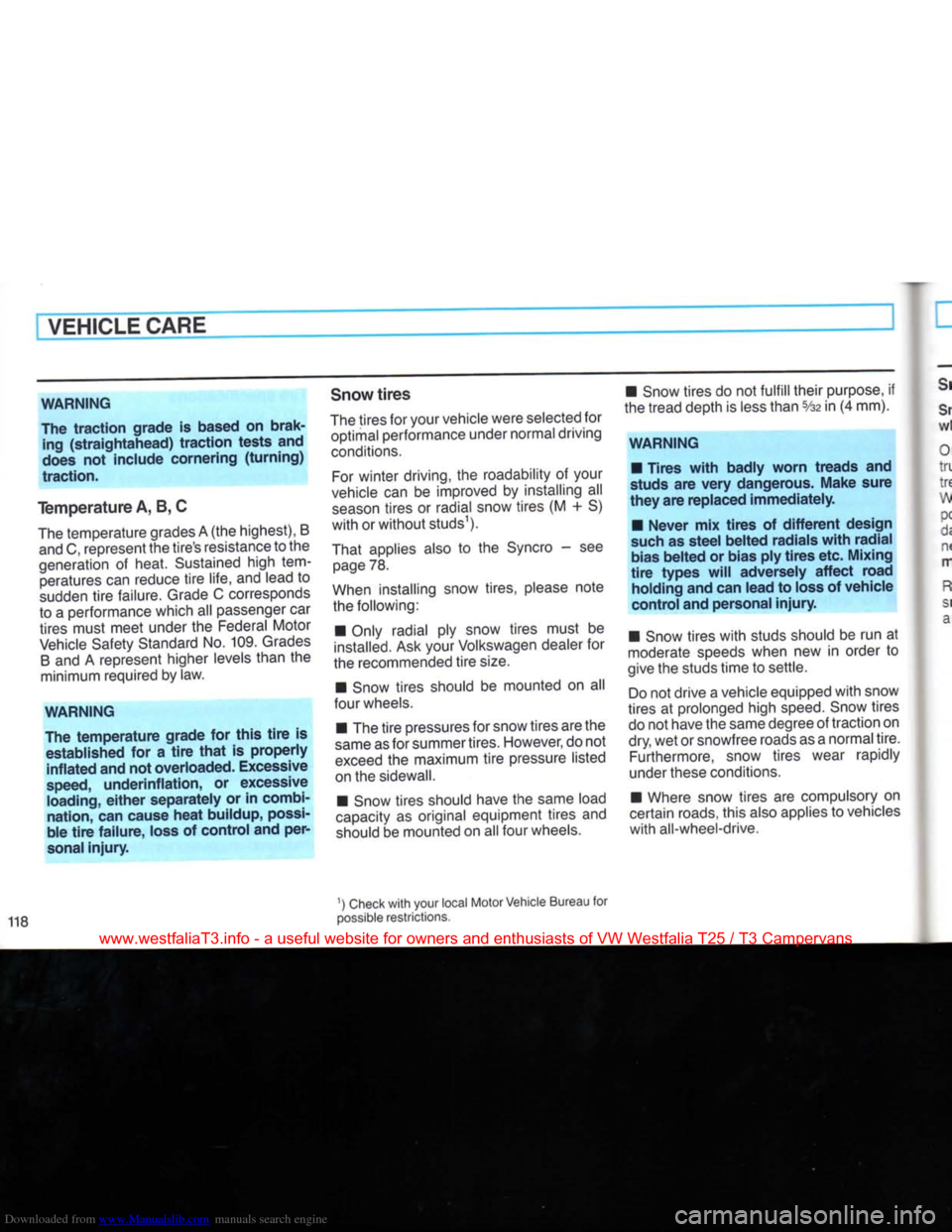
Downloaded from www.Manualslib.com manuals search engine
VEHICLE CARE
WARNING
The
traction
grade
is based on
brak
ing
(straightahead)
traction
tests
and
does not
include
cornering
(turning)
traction.
Temperature
A, B, C
The temperature grades A (the highest), B and C, represent the tire's resistance to the
generation of heat. Sustained high temperatures can reduce
tire
life, and lead to
sudden
tire
failure. Grade C corresponds
to a performance which all passenger car
tires must meet under the Federal Motor
Vehicle
Safety Standard No. 109.
Grades
B
and A represent higher levels than the minimum required by law.
WARNING
The
temperature
grade
for
this
tire
is
established
for a
tire
that
is
properly
inflated
and not
overloaded.
Excessive
speed,
underinflation,
or excessive loading,
either
separately
or in combi
nation,
can cause
heat
buildup,
possi
ble
tire
failure,
loss of
control
and
per
sonal
injury.
Snow
tires
The tires for your vehicle were selected for optimal performance under normal driving
conditions.
For
winter driving, the roadability of your
vehicle can be improved by installing all
season
tires or radial snow tires (M + S)
with
or
without
studs1).
That applies also to the Syncro - see page 78.
When installing snow tires, please note the following:
• Only radial ply snow tires must be
installed.
Ask your Volkswagen dealer for
the recommended
tire
size.
• Snow tires should be mounted on all
four wheels.
• The
tire
pressures for snow tires are the
same
as for summer tires. However, do not
exceed
the maximum
tire
pressure listed
on the sidewalk
• Snow tires should have the same load
capacity as original equipment tires and
should be mounted on all four wheels. • Snow tires do not
fulfill
their purpose, if
the tread depth is
less
than
%2
in (4 mm).
WARNING
•
Tires
with
badly
worn
treads
and
studs are
very
dangerous.
Make
sure
they
are
replaced
immediately.
•
Never
mix
tires
of
different
design
such as
steel
belted
radials
with
radial
bias
belted
or
bias
ply
tires
etc.
Mixing
tire
types
will
adversely
affect
road
holding
and can
lead
to loss of
vehicle
control
and
personal
injury.
• Snow tires
with
studs should be run at
moderate speeds when new in order to
give the studs time to settle.
Do
not drive a vehicle equipped
with
snow
tires at prolonged high
speed.
Snow tires
do not have the same degree of traction on
dry, wet or snowfree roads as a normal tire. Furthermore, snow tires wear rapidly
under these conditions.
• Where snow tires are compulsory on
certain roads, this also applies to vehicles
with
all-wheel-drive.
118 1)
Check
with
your local Motor Vehicle Bureau for
possible
restrictions.
www.westfaliaT3.info - a useful website for owners and enthusiasts of VW Westfalia T25 / T3 Campervans
Page 124 of 165
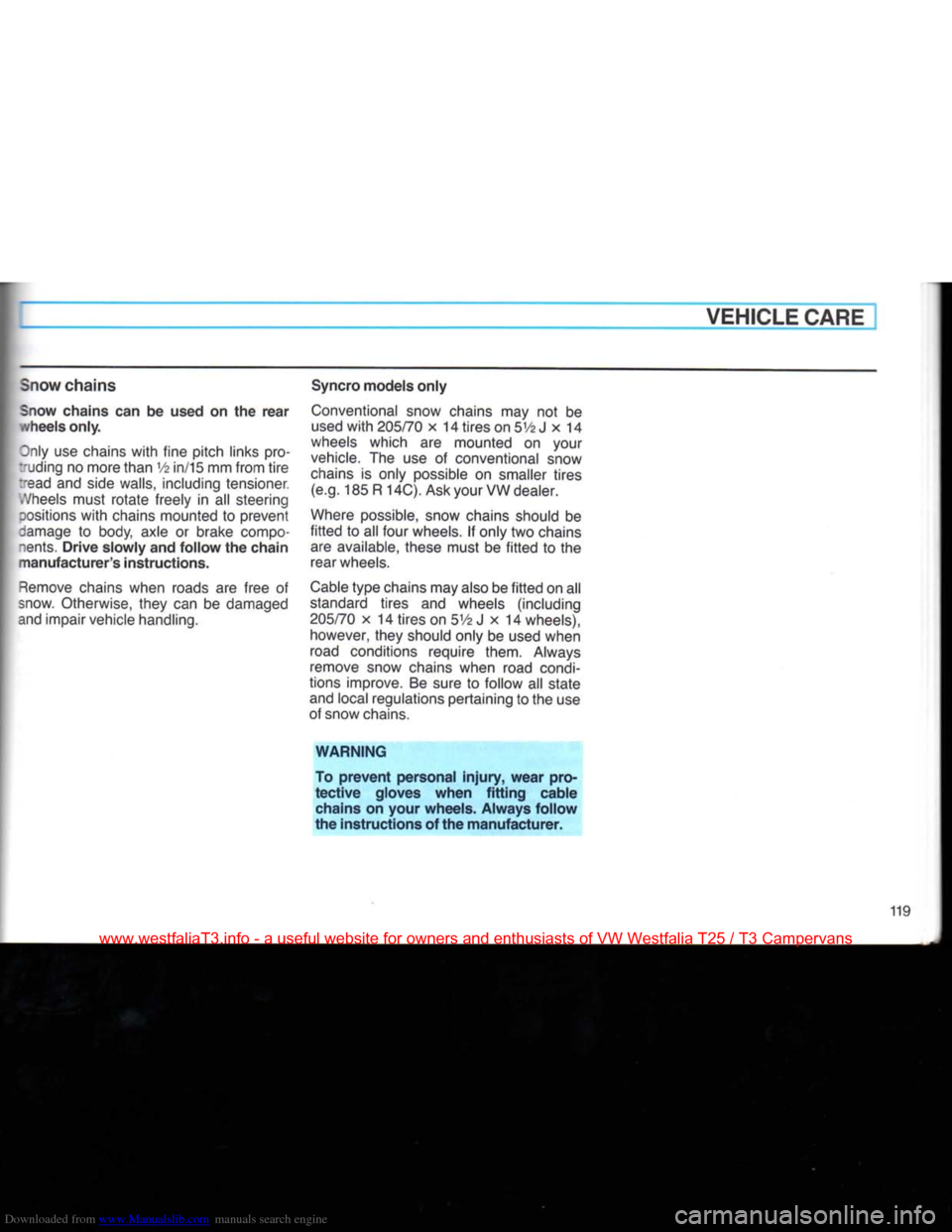
Downloaded from www.Manualslib.com manuals search engine
VEHICLE CARE
Snow
chains
Snow
chains
can be used on the rear ./heels only.
Dnly use chains
with
fine pitch links pro
dding no more than V2 in/15 mm
from
tire
"ead
and side walls, including tensioner.
.'/heels
must
rotate
freely
in all
steering
positions
with
chains mounted
to
prevent
damage
to
body, axle
or
brake compo
nents.
Drive slowly and follow the chain
manufacturer's instructions.
Remove
chains when roads are free
of
snow. Otherwise, they can
be
damaged
and impair vehicle handling.
Syncro models only
Conventional snow chains may
not be
used
with
205/70
x
14 tires on
5V2
J
x 14
wheels which
are
mounted
on
your
vehicle.
The
use
of
conventional snow
chains
is
only possible
on
smaller tires (e.g. 185
R
14C). Ask your VW dealer.
Where possible, snow chains should
be
fitted
to
all four wheels.
If
only two chains are available, these must be
fitted
to
the rear wheels.
Cable
type chains may also be
fitted
on all
standard tires
and
wheels (including
205/70
x
14 tires on 5Vz
J x
14 wheels), however, they should only be used when
road conditions require them. Always
remove snow chains when road condi
tions improve. Be sure
to
follow all state and local regulations pertaining to the use
of snow chains.
WARNING
To
prevent personal
injury,
wear
pro
tective gloves when fitting cable
chains
on your wheels. Always follow
the instructions
of
the manufacturer.
www.westfaliaT3.info - a useful website for owners and enthusiasts of VW Westfalia T25 / T3 Campervans
Page 143 of 165
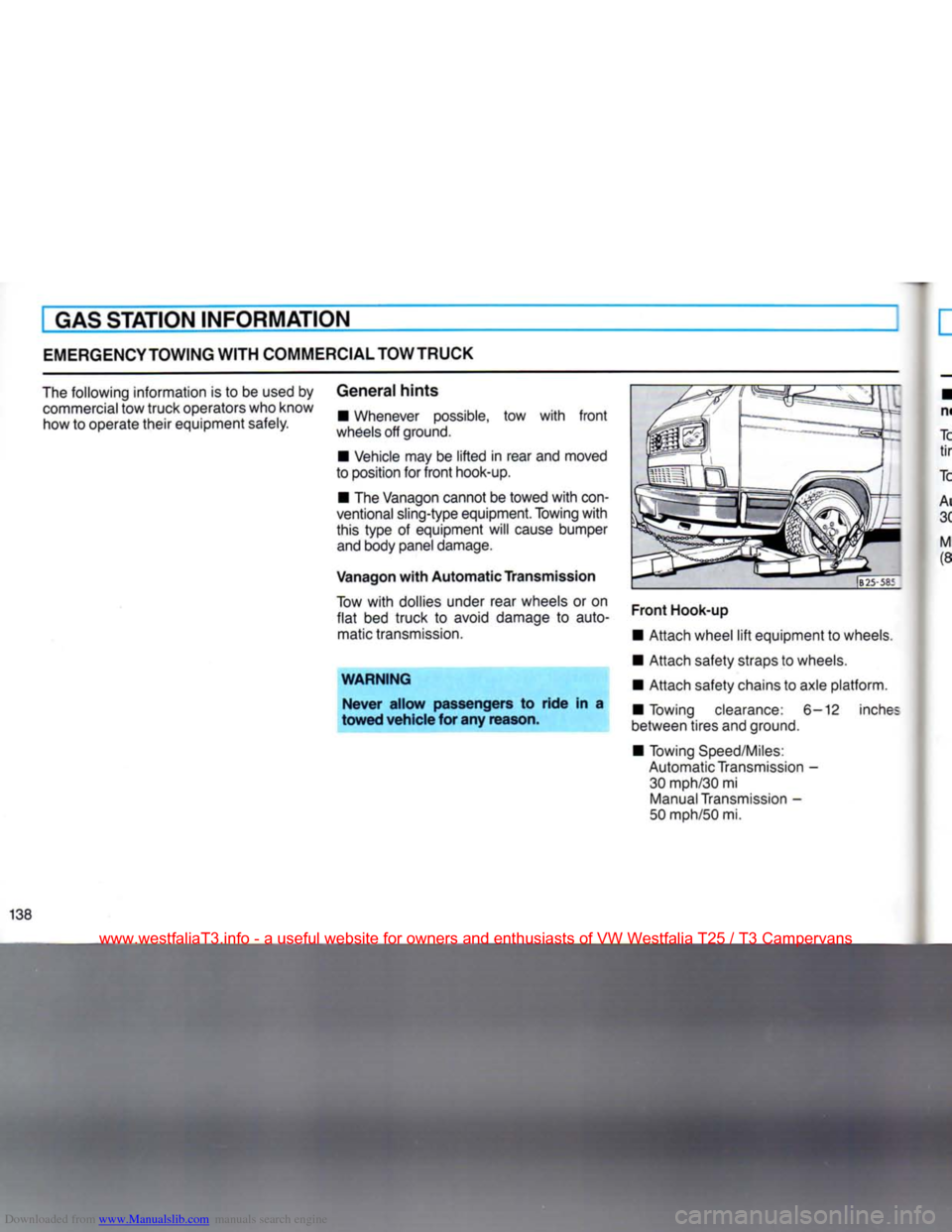
Downloaded from www.Manualslib.com manuals search engine
EMERGENCY
TOWING
WITH
COMMERCIAL TOWTRUCK
The
following information is to be used by
commercial
tow truck operators who know how to operate their equipment safely.
General
hints
•
Whenever possible, tow
with
front
wheels
off ground.
•
Vehicle may be
lifted
in rear and moved
to position for
front
hook-up.
•
The
Vanagon
cannot be towed
with
con
ventional sling-type equipment. Towing
with
this type of equipment will cause bumper
and
body panel damage.
Vanagon
with
Automatic
Transmission
Tow
with
dollies under rear wheels or on
flat
bed truck to avoid damage to automatic transmission.
WARNING
Never
allow
passengers to
ride
in a
towed
vehicle
for any reason.
Front
Hook-up
•
Attach wheel
lift
equipment to wheels.
•
Attach safety straps to wheels.
•
Attach safety chains to axle platform.
•
Towing clearance: 6-12 inches
between tires and ground.
•
Towing
Speed/Miles:
Automatic
Transmission
-30 mph/30 mi
Manual
Transmission
-
50 mph/50 mi.
138
www.westfaliaT3.info - a useful website for owners and enthusiasts of VW Westfalia T25 / T3 Campervans
Page 144 of 165
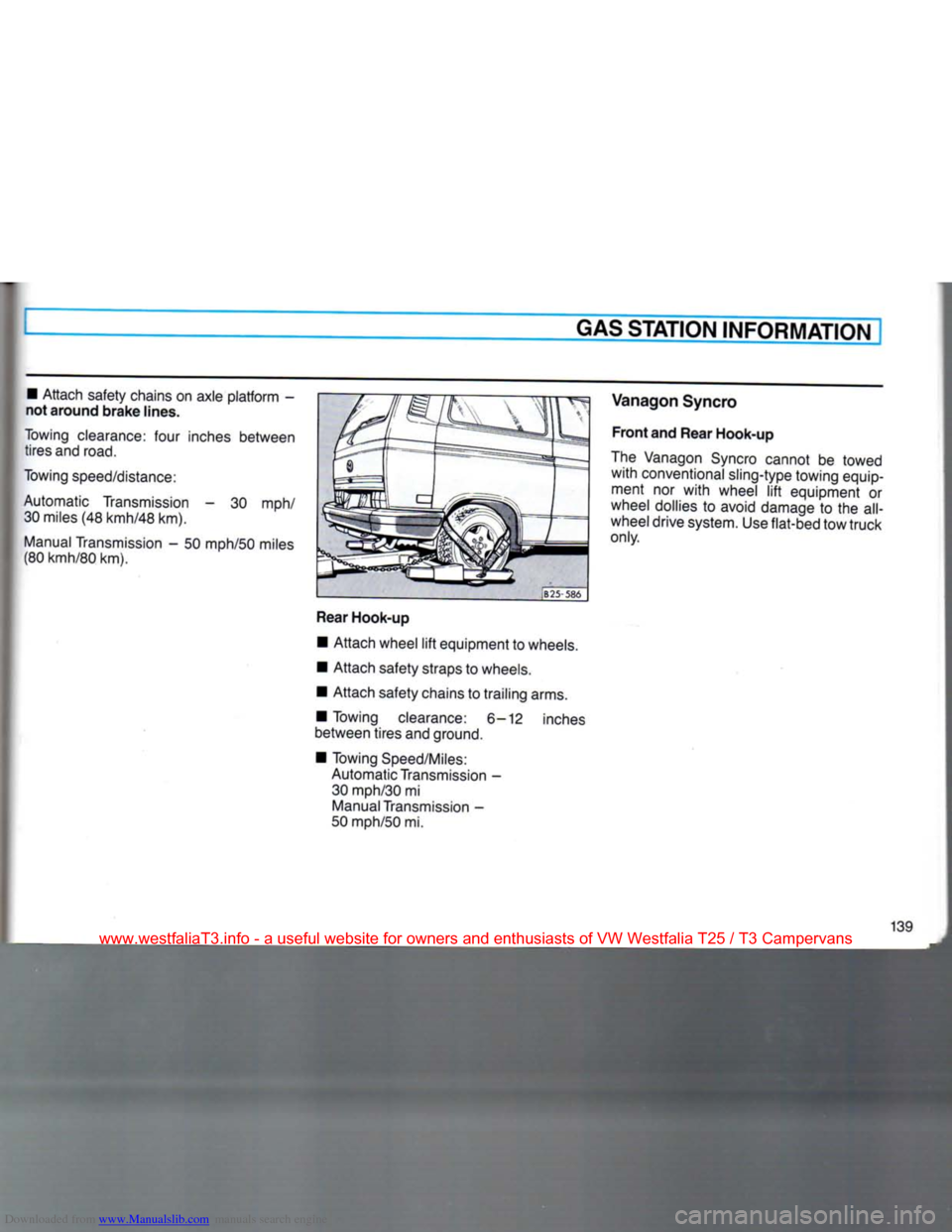
Downloaded from www.Manualslib.com manuals search engine
GAS
STATION
INFORMATION!
• Attach safety chains on axle platform -
not
around
brake
lines.
Towing clearance: four inches between
tires and road.
Towing speed/distance:
Automatic Transmission - 30 mph/ 30 miles (48 kmh/48 km).
Manual
Transmission - 50 mph/50 miles
(80 kmh/80 km).
|
B25-586
Rear
Hook-up
• Attach wheel
lift
equipment to wheels.
• Attach safety straps to wheels.
• Attach safety chains to trailing arms.
• Towing clearance: 6-12 inches
between tires and ground.
• Towing Speed/Miles: Automatic Transmission -30 mph/30 mi
Manual
Transmission -
50 mph/50 mi.
Vanagon
Syncro
Front
and
Rear
Hook-up
The Vanagon Syncro cannot be towed
with
conventional sling-type towing equipment nor
with
wheel
lift
equipment or
wheel dollies to avoid damage to the all-
wheel drive system. Use flat-bed tow truck
only.
139
www.westfaliaT3.info - a useful website for owners and enthusiasts of VW Westfalia T25 / T3 Campervans